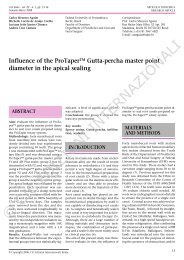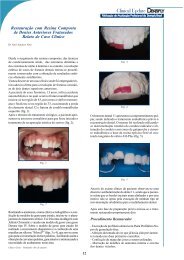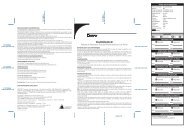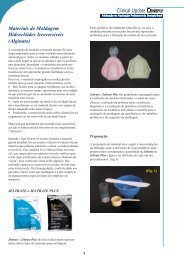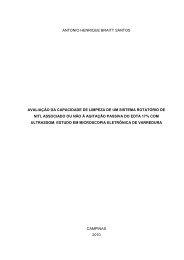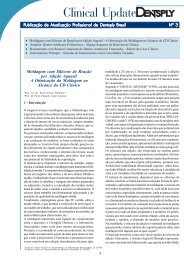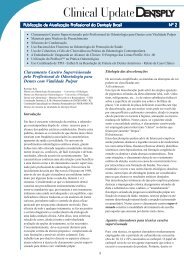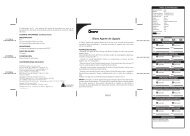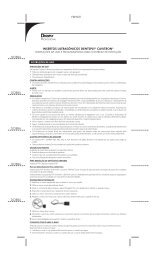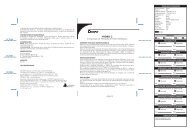You also want an ePaper? Increase the reach of your titles
YUMPU automatically turns print PDFs into web optimized ePapers that Google loves.
Rosales-Leal<br />
Fig 2 Percentage of cases with positive<br />
and negative permeability on the<br />
occlusal wall (O) and on the gingival<br />
wall (G) after 24-h water immersion<br />
(24 h) and 4000 cycles of thermocycling<br />
(4000 c). Columns with the<br />
same letter are statistically similar (p<br />
> 0.05).<br />
break the bond and facilitate leakage. 13,19 Another factor is<br />
that the substrate is a biological tissue, which makes adhesion<br />
difficult. 15 The third factor is the adhesive itself: the<br />
chemical composition plays an important role in achieving a<br />
strong, durable, and biologically compatible bond. 11<br />
Etch-and-rinse adhesives obtained hermetic sealing on<br />
the occlusal wall, which is surrounded by enamel. Enamel is<br />
mainly composed of minerals with no significant amount of<br />
organic compounds or water. 15 Use of phosphoric acid leads<br />
to pronounced etching depth. The adhesive covers a highly<br />
irregular mineral surface with no water, creating a hermetic<br />
and strong bond. 2,6,9,10,13 In contrast, self-etching adhesives<br />
exhibited slight leakage. In general, the pH of acidic<br />
primers is higher than that of phosphoric acid, resulting in a<br />
less pronounced etching effect. 4,21 The consequence in this<br />
in vitro study was a weaker bond with slight leakage. 6,8,15<br />
In agreement with other studies, 6,8,10,13,14 sealing was<br />
better along occlusal than gingival margins. The gingival wall<br />
is formed by dentin, which consists of minerals, organic<br />
compounds (mainly collagen fibers), and water. 15 In addition,<br />
dentin tubules cross the tissue and are full of water. After<br />
phosphoric acid treatment, there is a deep demineralization<br />
front in which the collagen network is exposed, dentin<br />
tubules are opened, and water content is increased. 17 Etchand-rinse<br />
primers have to infiltrate the exposed collagen, replace<br />
the water, and seal the tubules. Therefore, sealing is<br />
complicated, and this histological finding explains the higher<br />
leakage and positive permeability when etch-and-rinse adhesives<br />
are used. XPB was the best etch-and-rinse adhesive<br />
in this study, and always sealed the dentin tubules. This adhesive<br />
uses tertiary butanol as a solvent and provides an increase<br />
in resin content. After polymerization, the bonding<br />
layer will be thicker and consist of a dense polymer matrix<br />
that promotes better sealing.<br />
Self-etching adhesives (except IBO) obtained higher<br />
dentin sealing capability than etch-and-rinse adhesives. To<br />
etch and infiltrate at the same time assures proper covering<br />
of the demineralized dentin and avoids the problem of water,<br />
which etch-and-rinse adhesives have after phosphoric<br />
etching. 4,11 The lower primer acidity promotes less tubule<br />
opening, 14 and then tubule sealing was demonstrated to be<br />
easier. 6 The consequence is that self-etching adhesives always<br />
sealed the dentin tubules and yielded lower leakage<br />
than etch-and-rinse adhesives. In accordance with others,<br />
6,15 IBO allowed more leakage than other adhesives tested.<br />
Despite the higher leakage, IBO sealed always the dentin<br />
tubules.<br />
Evaluation of the dentin permeability to the dye solution<br />
shows the adhesive ability to seal the dentin tubules. 16 Within<br />
the limits of a microleakage study (not being a nanoleakage<br />
evaluation), it can be concluded that if there is leakage<br />
but no positive permeability, the interface failure will be located<br />
over the intact dentin. In this situation, penetrating<br />
bacteria will be surrounded by resin interfaces which could<br />
slow down secondary caries development. In fact, pulp inflammation<br />
was measured in vivo, 12 and when the bacteria<br />
progressed between the cavity and the composite, a low level<br />
of pulp inflammation was found. However, if the bacteria<br />
progress into the dentin tubules, the inflammatory activity is<br />
higher. 3 Therefore, it is desirable to achieve sealing of dentinal<br />
tubules.<br />
Thermocycling is an easy method to age restorations and<br />
results in the highest clinically relevant stress. 3,18 As was<br />
demonstrated in others studies, 18 thermocycling did not af-<br />
258 The Journal of Adhesive Dentistry



